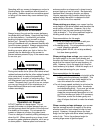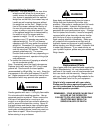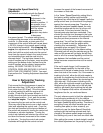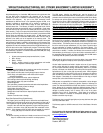
11
¼” allen wrench at the Return-to-Neutral (RTN)
mechanism, if necessary. It is normal to make
these adjustments from time to time.
How to Test/Use the Blade
Clutch/Brake Switch
Before testing the blade clutch/brake operation,
make sure the area is clear and there is nothing
vulnerable to thrown objects from under the
mower. No one should be near the mower deck
or in its line of discharge. The discharge chute
deflector should be in the down position. The
parking brake should now be applied. Move the
engine throttle to ¾ speed setting. When
mowing, the engine speed should always be at
its highest setting. The engine governor will
regulate the engine according to the different
mowing conditions at that setting. Place both
feet firmly on the foot platform and turn on the
blade clutch switch. Run blades for a minute or
so. Try engaging and disengaging the blades a
few times about 10 seconds apart. If the blades
do not start and stop in a few seconds each
time, service the blade brake system or contact
your local Wright dealer. Under mowing load,
the clutch’s life will be the greatest if engaged
and disengaged at the ¾ throttle level.
How to Test the Operator Presence
Control (OPC) Switch
With the parking brakes applied and the blades
ON, try lifting your feet off the foot platform to
test the Operator Presence Control switch
(OPC). The engine should kill and the blades
should stop within a few seconds. If not, service
the OPC system or contact your local Wright
dealer.
Service and Adjustments
Tire Maintenance and Pressure
Excessively worn tire tread is dangerous on all
hills. Replace drive tires with less than 3/32” of
any tread groove left. Use tires with the tread
pattern recommended by Wright Mfg., Inc. only.
Keep the tire pressure in the drive tires between
18 and 22 psi. Higher pressures will cause the
tires to have less traction, which will force you to
go slower and with less safety and give you a
harder ride. Keep the tire pressure in the front
caster tires between 30 and 40 psi. Higher
pressures will help keep the caster tires on their
rims when impacted from the side but give a
harder ride. They do not have any tread but
should be replaced when excessively worn.
Height-of-Cut
Before Adjusting the Height-of-Cut be sure of
proper air pressure in all four tires and check for
even tire wear. The height-of-cut can be
adjusted the following ways:
l Coarse Adjustment
: For the coarse adjustment
the rear wheels, the front casters and the
anti-tip rollers should be adjusted at the
same time. Adjust the rear wheel motor
supports equally in one of the three settings
up or down 0.75" each in a 1.5" total range.
a. Use the highest holes in tractor frame
for cutting heights of 1.75" - 3.0".
b. Use the middle holes in tractor frame
for cutting heights of 2.5" - 3.75",
factory setting.
c. Use the lowest holes in tractor frame
for cutting heights of 3.25" - 4.5".
The anti-tip rollers at the back end of the
mower must be adjusted to correspond
to the above holes used for the coarse
wheel motor support adjustment:
There are four holes in the anti-tip roller
support brackets. Use the rearward holes
only when the hydraulic motor supports
are in the rearward position and vice
versa. See the section above, "Hydraulic
Motor Support Adjustment".
Use the higher holes for the anti-tip roller for
motor supports in highest holes in tractor
frame, setting "a" above.
Use the lower holes for the anti-tip roller for
motor supports in middle or lowest holes
in tractor frame, settings "b" or "c" above.
WARNING
Adjust the front caster arms at their
respective support brackets equally in
one of the seven settings up or down
0.25" each through a 1.5" total range.
a. This should be done with two shims
(or "C" spacers) on the bottom and
one shim on the top of the caster
support arm.
b. The front-to-rear leveling of the blades
should be between level (preferred)
to .25" lower at the front of the blades
but never higher at the front.
c. Use the lowest holes in tractor frame
for heights of 3.25" - 4.5".


















